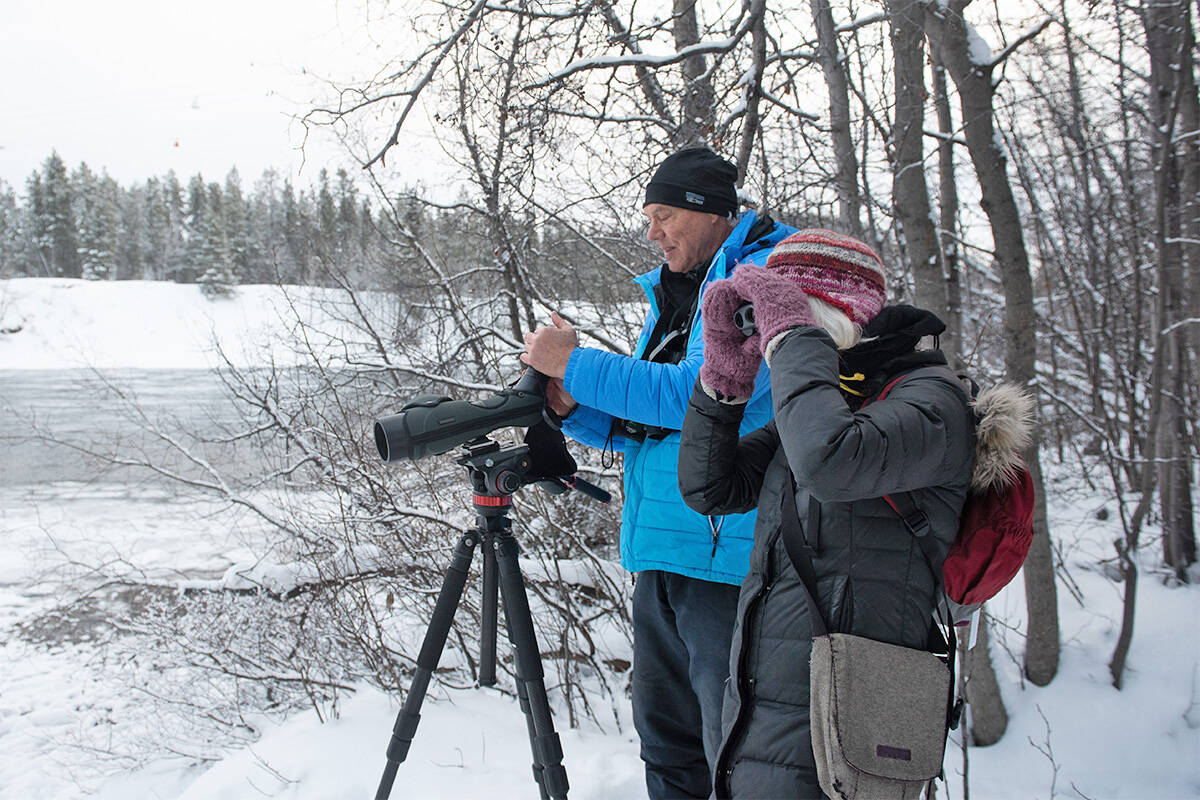More than 9,900 birds of 71 different species were accounted for in Homer during the 50th consecutive Homer Christmas Bird Count on Dec. 18, 2021. The Homer Christmas Bird Count is sponsored by the Kachemak Bay Birders and the U.S. Fish and Wildlife Service, Maritime Refuge, and was hosted in accordance with the 122nd Audubon Christmas Bird Count.
Homer joined roughly 2,700 communities across the world to create a log of the birds found in the area during this time of the year.
“It’s basically a snapshot in time of what birds are where,” Dave Erikson, Homer Christmas Bird Count organizer, said. “We get an idea of how many birds there are, where they are in relative terms.”
Erikson has organized the Homer Christmas Bird Count for 45 years.
The 2021 Christmas Bird Count was conducted by 27 volunteers who covered the traditional 15-mile diameter count circle, which was centered in Mud Bay and included individual bird feeders, according to the count results summary prepared by Erikson. The volunteers received a refresher course on bird identification before the count day to ensure accurate species reporting.
The annual count day saw 9,904 birds in the Homer area, including a new species never seen before during the count, a red-winged blackbird. Additionally during the count week, snow buntings and a northern harrier were spotted, but were not seen during the official count day. The 2021 count remained on average with previous years, Erikson said.
While the red-winged blackbird was accounted for for the first time in Homer, Erikson said the most interesting bird the crew spotted was the brambling, a Eurasian finch, which has only been listed on the Homer Christmas Bird Count four times now. The brambling is normally found in Western Europe to Eastern Siberia, but a few sometimes make their way to Alaska, making them a highlight of any birding adventure, Erikson explained.
“It is a very interesting and beautiful bird, but it’s not that unusual,” Erikson said. “We always like to see them when they get here though.”
The most commonly-seen bird this year was the rock sandpiper, Homer’s winter resident shorebird, with 2,700 birds counted. Following in second and third places are the black scoter with 861 and the American crow with 598.
Of the 71 species included in this year’s count, 11 were represented by only one bird, Erikson said.
One oddity Erikson noted was the lack of American robins, which had been spotted regularly in the weeks leading up to the count, but on the official counting day, only one was to be found.
While local birders find joy in spending the day searching for birds across Homer, their findings provide an in-depth look into bird populations for Audubon to utilize in research.
“They’ve used this data for all kinds of scientific publications over the years,” Erikson said. “They’ve also used this along with the breeding bird surveys to document that we have lost 3 billion birds in this area over the last 50 years.”
When asked what caused the loss in bird populations in Homer, Erikson’s answer was short. “Humans,” he said. “Humans, climate change, loss of habitat …”
“This is a very invaluable survey over time, and we’ve done this for over 50 consecutive years in Homer, so we’ve got to witness changes in this area.”
The birds accounted for were: Mallard-160, Downy Woodpecker-23, Greater Scaup-321, Hairy Woodpecker-5, Scaup sp.-3, American Three-toed Woodpecker -1, Steller’s Eider-5, Northern Flicker-1, Common Eider-5, Northern Shrike-9, Harlequin Duck-27, Canada Jay-13, Surf Scoter-64, Steller’s Jay-22, White-winged Scoter-16, Black-billed Magpie-120, Black Scoter-861, American Crow-598, Long-tailed Duck-114, Common Raven-149, Bufflehead-31, Black-capped Chickadee-190, Common Goldeneye-247, Boreal Chickadee-47, Barrow’s Goldeneye-1, Red-breasted Nuthatch-149, Common Merganser-17, Brown Creeper-8, Red-breasted Merganser-14, Pacific Wren-4, Ring-necked Pheasant-56, Golden-crowned Kinglet-1, Red-throated Loon-2, American Robin-1, Pacific Loon-2, Varied Thrush-1, Common Loon-12, European Starling-1, Loon, unid-1, Snow Bunting-CW, Horned Grebe-13, Bohemian Waxwing-559, Red-necked Grebe-4, American Tree Sparrow-3, Pelagic Cormorant-31, Fox Sparrow-3, Northern Harrier-CW, Dark-eyed Junco-130, Sharp-shinned Hawk-11, Dark-eyed (Oregon) Junco-15, Northern Goshawk-7, Dark-eyed (Slate-colored) Junco-91, Bald Eagle Mature-112, Bald Eagle Immature-29, White-crowned Sparrow-16, White-throated Sparrow-1, Rock Sandpiper-2,700, Golden-crowned Sparrow-12, Dunlin-1, Song Sparrow-15, Common Murre-3, Red-winged Blackbird-2, Pigeon Guillemot-17, Brambling-2, Marbled Murrelet-3, Gray-crowned Rosy-Finch-500, Short-billed (Mew) Gull-163, Pine Grosbeak-163, Herring Gull-6, Red Crossbill-110, Glaucous-winged Gull-239, White-winged Crossbill-125, Glaucous-winged Gull/Herring Gull-1, Common Redpoll-396, Glaucous Gull-1, Pine Siskin-565, Rock Pigeon-176, small finch sp.-370, Northern Hawk Owl-1, Great Horned Owl-1.
At the end of the count day on Dec. 18, the Kachemak Bay Birders presented Erikson a certificate and gift of appreciation for his 45 years of service as the coordinator and compiler of the annual Christmas Bird Count. National Audubon also wrote a letter commending Erikson for his many years of dedication to the count.
Erikson worked as a biologist for the Alaska Department of Fish and Game and originally had an interest in participating in the count, but never found himself in town when it happened. In 1976, he was in town and decided to see how he could help.
“I’ve been involved ever since,” Erikson said.
For more information about the 2021 Christmas Bird Count, visit kachemakbaybirders.org/.
Reach reporter Sarah Knapp at sarah.knapp@homernews.com.


